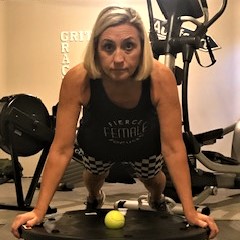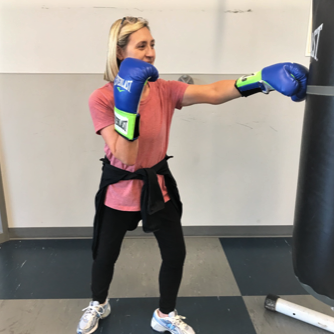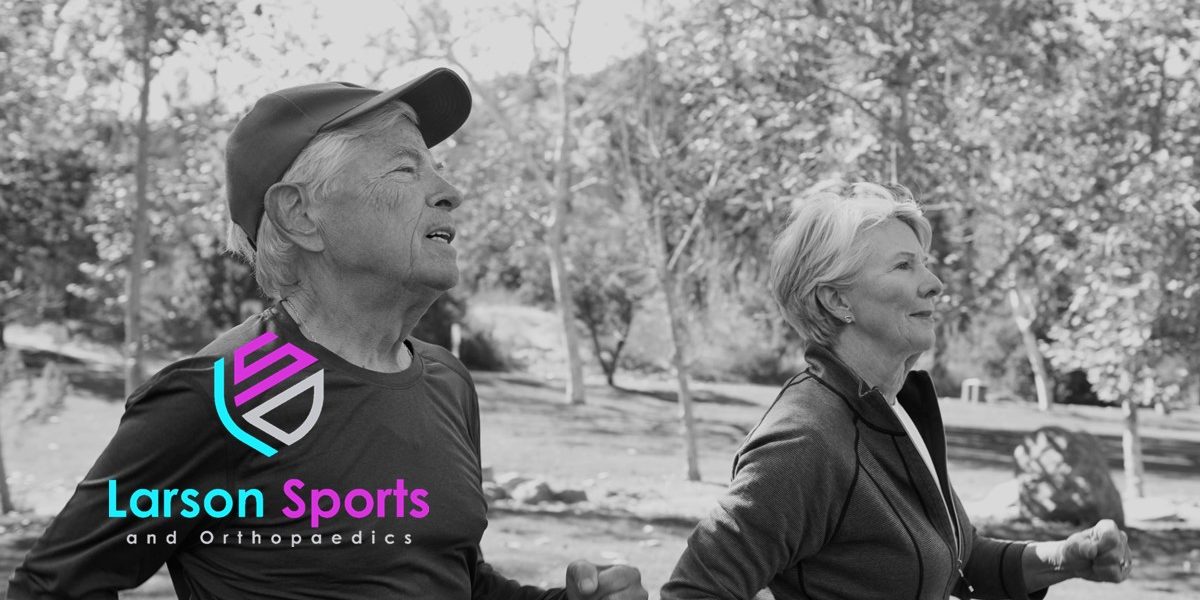Parkinson’s disease affects over ten million people worldwide. And 60,000 new cases of Parkinson’s are diagnosed each year. And the search for more effective treatments progresses each year. But we often forget one of the oldest treatments available: Exercise. But many people worry about exercising with Parkinson’s and fear injury. Well, I’m here to tell you that not only is it safe to exercise with Parkinson’s, but it can also really help keep the disease at bay.
As a Certified Health and Wellness Coach, I am well aware of the protective benefits of exercise. We’ve all heard about these benefits, right? Exercise has been well documented to offer protective value against heart disease and maintain brain health. Little did I know how much exercise would impact my life. Allow me to introduce myself and share my story.
My name is Teresa Jackson. In February of 2019, I was diagnosed with Parkinson’s disease. I was 55 years old, in fairly good health and actively working. Before I share my journey, I’d like to share some Parkinson’s related information with you.

What Is Parkinson’s Disease?
Parkinson’s is a disease that involves degeneration of the substantia nigra, a portion of the brain crucial to controlling movement. We do not know the cause of this degeneration, unfortunately. But the cells in this area of the brain begin to die off, leaving us with worsening muscle function and poor control over our own bodies.
Symptoms of Parkinson’s Disease
Most people are familiar with the tremors associated with Parkinson’s. But it also causes slowed movements and rigid muscles. These can cause problems with balance and frequent falls. Over time Parkinson’s can lead to problems with even the most basic functions that we all take for granted: speech, swallowing, and even blinking.
Parkinson’s Statistics
According to the Parkinson’s Foundation, one million people in the United States will be living with Parkinson’s by 2020 and over ten million people worldwide. There are 60,000 newly diagnosed cases each year. Men are 1.5 times more likely to be diagnosed with the disease than women. Only four percent of PD patients are diagnosed before the age of 50; these diagnoses are referred to as early-onset Parkinson’s disease. The combined direct and indirect cost of this disease including treatment, social security payments and lost income is 52 billion dollars per year in the US alone.
Living With Parkinson’s
Behind these statistics are real people; people just like me. People that wake up one day, and realize that something strange is happening to their bodies. Something isn’t quite right. Perhaps family, friends or even co-workers notice it before the patient does. Regardless, people’s lives and the lives of the people that love them, are about to forever change. This is where my story begins.

My Parkinson’s Story
In the fall of 2017, while chatting on Facetime, my daughter noticed a tremor in my left hand. She asked why the phone was shaking, something I hadn’t even noticed. I dismissed her comments and didn’t give it much thought since it was intermittent. Life was busy with the normal activities of mid-life; two adult children, working full time, volunteering and spending time with my husband of 34 years. Fast forward to the summer of 2018.
It Started With Tremors
The tremor was more prevalent and had now taken up residence in my right hand as well. Still being irregular, I dismissed it as fatigue and stress. But by August, it was more than intermittent, so I decided to schedule a visit with my primary care physician.
Of course, the day that my appointment arrived, my hand is calm as smooth waters. It reminded me of taking my car into the shop, trying to describe the noise its making and the car performing splendidly while in front of the mechanic. There wasn’t much to see that day and with my vitals normal, she too dismissed it as stress. But by November, I began to have difficulty descending stairs.
Weakness Came Next
I normally ran the stairs between meetings at work and I noticed that my legs felt unusually weak. But. I couldn’t lift my legs to run downstairs, no matter how hard I tried. I remember thinking to myself that I wasn’t doing enough strength training and this must be a part of normal aging. Armed with additional symptoms, I made an appointment to see my primary care physician again.
This time my doctor noticed the tremor.
She performed some testing, to include having me walk a straight line. There was a bit of a wobble, but I was able to carry out her requests. It wasn’t until she requested I close my eyes and repeat the same straight line that real trouble appeared. I closed my eyes and tried to put one foot in front of the other and to my surprise, and hers as well, I fell to the floor, heels, dress and all. I’m not sure who was more shocked, the physician or me.
But at the wedding, my son could tell something was wrong. As he was getting ready to escort me to my seat he said: “Mom, I can feel you shaking.” I knew this was much more than mother-of-the-bride jitters. But I smiled and said “I’m fine.”
Denial
I sat up, regained my composure and she asked me to sit at the exam table. She asked questions like “has anyone in your family been diagnosed with Parkinson’s?” My head began to swim and I couldn’t remember the answer to this simple question. She suggested I have a brain MRI and that I see a neurologist and she made a referral.
On the heels of that November appointment, was my daughter’s wedding at the end of December. I began to tell myself that I probably had a nutritional imbalance and I had nothing to worry about. So, I made the decision to put off the neurology appointment until after her wedding. However, at the wedding, my son could tell something was wrong. As he was getting ready to escort me to my seat he said: “Mom, I can feel you shaking.” I knew this was much more than mother-of-the-bride jitters. But I smiled and said, “I’m fine.”
Daily Symptoms Worsen
By January, more symptoms appeared: my dexterity began to fail me. Placing change back in my wallet became difficult. It was hard to put a shirt on a hanger. It was hard making a call on my cell phone.
In addition to those symptoms, my legs began to cramp, sometimes for hours. In addition, I began to struggle with balance. Large crowds were becoming difficult. While attending a networking event, I felt like I was falling backward. I found myself hanging onto a table.
Diagnosing Parkinson’s
Feb. 6th, 2019 arrived like any other day. My husband and I were scheduled to take a quick trip before he deployed out of the country. I was still convinced I had a nutritional imbalance and was expecting the neurologist to confirm it. So we set off toward the airport with a quick stop by the neurologist’s office.
This is where my world changed. The neurologist spent about ten to fifteen minutes asking me questions, checking my gait, reviewing my MRI, which was normal, and then said those words. “Mrs. Jackson, you have Parkinson’s disease.”
What? My head began to swim again and I wasn’t sure if I was going to pass out or vomit. I sat in complete disbelief. Stinging hot tears welling up in my eyes and spilling over onto my cheeks before I could compose myself. I looked over at my husband and could see that he was shell-shocked. He was staring, not moving, not saying a word.

Parkinson’s Questions
I took a deep breath and asked the doctor if he was sure. Could there be another explanation? Will I be in a wheelchair? Will I have to quit work? All the answers came back, “I just don’t know.”
Throw me a lifeline here, please! He said he would write me a prescription and could see me back in six months. That’s it? You’ve just informed me that I have a disease with no cure that is progressive, you don’t know the trajectory of my course and here’s a prescription? For what? It seemed as though thousands of questions were firing in my brain like a machine gun. My husband and I stood as I steadied myself and we left the office.
This Can’t Be Me
You may remember we were headed to the airport for a trip. We walked in total silence to my husband’s truck. Then we hopped inside, closed the doors and drove the next thirty minutes to the airport in total silence. When we arrived at the airport I turned to my husband and said, “I do not have Parkinson’s. I am too young and too healthy. I have a nutritional imbalance. We are going to take this trip, enjoy it, and when we return you will deploy like normal. I will seek a second opinion and figure this out.”
We exited our automobile and walked to the terminal. The weekend was dampened but we managed to enjoy ourselves a bit through a healthy dose of denial.
Accepting The Diagnosis
February rolled into March. I saw another neurologist. This time my husband didn’t accompany me as he was already deployed out of the country. No need to, remember: I was sure I didn’t have Parkinson’s. Unfortunately, the doctor did not agree. For the second time, I received the same diagnosis. She offered a prescription; this time I accepted. She left the room. I gathered my personal belongings and I walked to my car.
More Questions
While sitting in my car, lost in thought, the realization came to me that I didn’t know much about this disease. How do I take care of myself? What impacts this disease? Will I die early? Is there anything I can do to make it better? Can I lead a quality life or will I be in a wheelchair by Christmas? How could a patient be given a life-changing diagnosis with no education about this disease? There were so many questions and so few answers.
My husband and I had numerous discussions on what was best for me following this diagnosis. The one thing we knew for sure was we felt alone. After much discussion and prayer, we made the decision to leave my job. We decided that I would learn as much about this disease as possible, and help guide others through this process and make the transition to life with Parkinson’s easier than mine had been.
As I mentioned at the beginning of this article, I am a Certified Health and Wellness coach. After leaving my job, I returned to school and earned my certification as a Health and Wellness Coach. Now my job is to use my experience and knowledge to help others that find themselves just as lost and alone as I was.
“How will I take care of myself? Is there anything I can do to make it better? Will I be in a wheelchair by Christmas?” There were so many questions and so few answers.
Standard Treatments For Parkinson’s
While there are medications and surgeries for Parkinson’s, we are always looking for better ways to treat the disease. And one thing that these treatments have in common: they are things that are done TO YOU, not BY YOU. And one thing I’ve learned as a Health and Wellness Coach is that the capacity to take control over your life and the diseases that affect it can be one of the most powerful factors in restoring your sense of self after an earth-shattering diagnosis.
That being said it is important to remember that exercise is just ONE PART of your treatment plan for Parkinson’s Disease. By no means should it be the only treatment you use to treat this disease. The medications that your physician recommends are a vital part of the treatment. But I find that exercise is often forgotten about entirely. This is why I make such an effort to promote this important piece of your total care plan.
Move It Or Lose It: Exercise For Parkinson’s Disease
Through a lot of research, I discovered that exercise offers some of the greatest impacts on the health of Parkinson’s patients. But I wasn’t given this information at my diagnosis. Nor did I find many doctors that were willing to put much faith in exercise. And even fewer were willing to recommend it.
But according to the Parkinson’s Foundation and supported by research, exercise is a vital part of staying healthy for the Parkinson’s patient. It improves balance, strength, mood, mobility, and activities of daily living. Exercise may also have positive impacts on depression and anxiety, which are common symptoms of Parkinson’s.
Benefits of Exercising with Parkinson’s
A diagnosis of Parkinson’s Disease doesn’t mean you are doomed to a wheelchair. In fact, those who are overly cautious can worsen their descent into diminished function and limited life. By living afraid to move, you will ensure that movement becomes more difficult and dangerous.
And as the disease progresses, stumbles and falls will become more common. And people often worry about falling while exercising. But exercise can make these falls less common. And exercise can keep your bones strong, to help prevent fractures and other injuries when you do fall. In fact, it has been recommended that “vigorous exercise should be accorded a central place in our treatment of Parkinson’s Disease.”
The Parkinson’s Outcomes Project showed that people with PD who start exercising early and at least 2.5 hours a week can slow their decline in function dramatically. Exercise can do all of the following for Parkinson’s Patients:
- Improved Balance
- Better Coordination
- Faster Ambulation
- Longer Lifespan
- Fewer Injuries
- Improved Cognition and Memory
- Better Quality of Life
How Does Exercise Help Parkinson’s?
The body adapts to the stresses we put upon it. And there is evidence that when we stop using our limbs, the areas of the brain that control them actually atrophy as well. Similarly, we know that the brain is remarkably adaptable. This is seen when stroke patients regain functions after sustaining severe brain damage and the death of large groups of neurons. So by forcing ourselves to continue exercising, we force the brain to continue finding ways to move our limbs and we can keep up with the damage done by the disease.
Further, animal models of Parkinson’s show that there are actually toxins in the brain that can kill the dopaminergic nerve cells in the substantia nigra. But in these same animal models, we see that exercise helps the brain to protect itself from these toxins, preventing the brain cells from dying in the first place.

What Kind Of Exercises Should Parkinson’s Patients Do?
You may wonder if all exercise is the same. The short answer to that question is “no.” Exercise programs should include flexibility exercises, aerobic type exercises, and strength training. Some fitness disciplines focus on these as a primary principle of their training. And other exercise programs have been adapted specifically for Parkinson’s patients. These include
- Tai Chi
- Yoga
- Pilates
- Dance for PD
- Rock Steady Boxing
While all exercise is beneficial, any exercise that makes you breathe hard and sweat are thought to yield better results. (Dr. Larson here: be sure to check out our article on the Importance of Exercise Intensity for more details.) However, as with any exercise program, consult your neurologist and/or primary care physician to ensure you are safe to start exercising and which exercises are best suited for you.
My Experience With Exercise and Parkinson’s
As for me, I participate in Rock Steady boxing three times a week. I take a one-hour ballet class each week. I work out with a personal trainer once a week, and my husband and I walk several miles each week. I’ve found exercise to be invaluable to maintaining my freedom, function, and sanity.
Finding Your Parkinson’s Team
Occupational Therapists and Physical Therapists can be integral in teaching your safe and accommodative movement patterns. If you have access to a Physical Therapist that specializes in treating Parkinson’s Disease, they can also work with your neurologist to design a program specific to you. You can find a therapist near you at this link: Parkinson’s Therapists.
And choosing the right neurologist is an integral part of this picture as well. I now have a neurologist that sits with me each time I visit him and makes sure I am educated on my disease and how to take care of myself. He shares the latest information on research and I feel I have a partner in taking care of myself. He is available to me by email within 24-48 hours should I have questions.
And finally, let’s not forget our care partners. They play an important role in the care that Parkinson’s patients receive. They can be our confidant, our friend, and our soul mate. I know mine is.
Social Benefits of Regular Parkinson’s Exercise
In addition to physical benefits, there are a few additional items that help PD patients live a life of quality. Staying connected to the community can improve all of our well-being, and Parkinson’s patients are no exception. The symptoms of Parkinson’s can be very isolating. We sometimes shy away from social settings, but fitness classes with other Parkinson’s patients can be remarkably uplifting. It can keep you connected and build a new community for you and your family.
Parkinson’s Diets
While there are no specific PD diets, maintaining healthy eating is important to overall health. Remember to eat lots of fruit and vegetables, decrease junk food and refined sugar as well as foods with little or no nutritional value.
Mindset For Parkinson’s
Take time during your day to relax and remember to stay positive. Perhaps keep a gratitude journal, or meditate or pray as a way to focus on what you can do, not what you can’t do. Gratitude can shift our way of thinking.
Set goals; not New Year’s resolutions but goals. Work toward those goals and reward yourself as you accomplish them. As for me, I have a few goals in mind for 2020. To name a few, I am writing a book about my journey, learning to play the saxophone, and seeking public speaking opportunities to change the narrative of how Parkinson’s Disease patients can gain education on the necessity of exercise in taking care of themselves. In addition, I am competing in the 2020 Mrs.Virginia pageant with a platform of Parkinson’s Awareness.
Resources For Parkinson’s Patients
- Michael J Fox Foundation
- Parkinson’s Foundation
- And please, stay out of the social media communities for Parkinson’s. I find they are usually full of false information.
Other Articles You May Like
- The Bionic Athlete: Returning To The Gym After A Joint Replacement
- Too Much Too Soon: Exercises To Avoid After A Hip Replacement
References
- The Effect of Physical Activity in Parkinson’s Disease: A Mini-Review
- Tai Chi and Postural Stability in Patients with Parkinson’s Disease
- Rehabilitation Interventions in Parkinson’s Disease
- Does vigorous exercise have a neuroprotective effect in Parkinson’s disease?
- The effects of exercise on cognition in Parkinson’s disease: a systematic review

